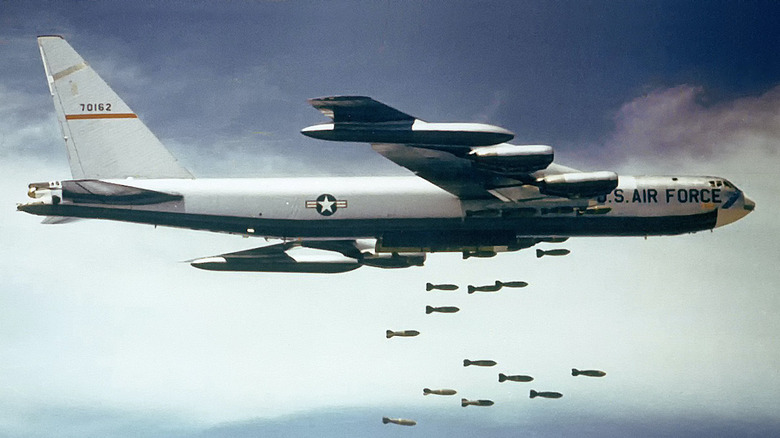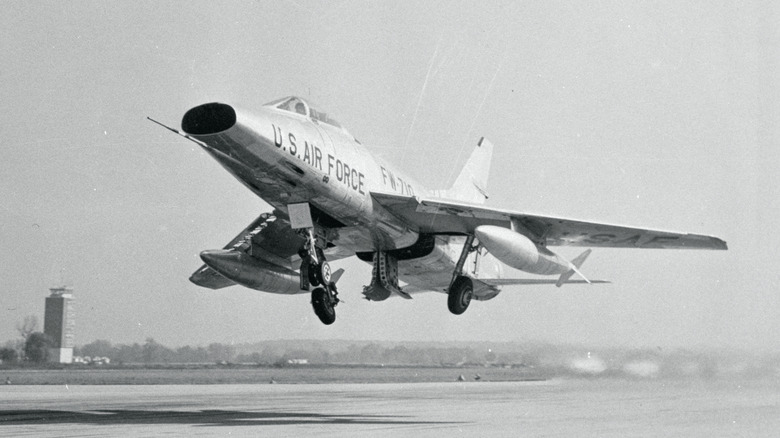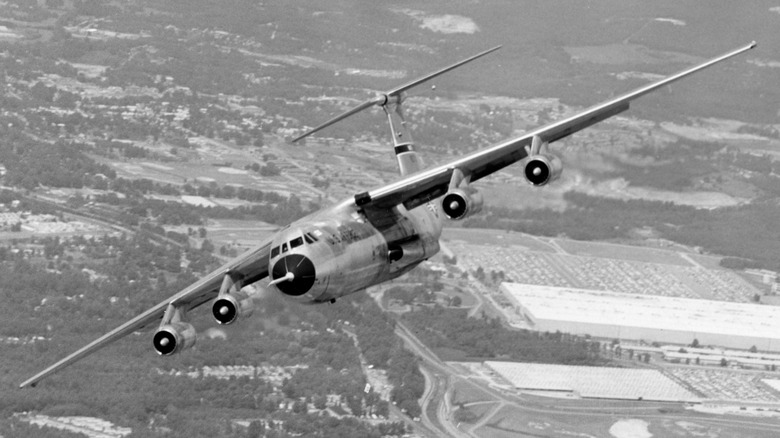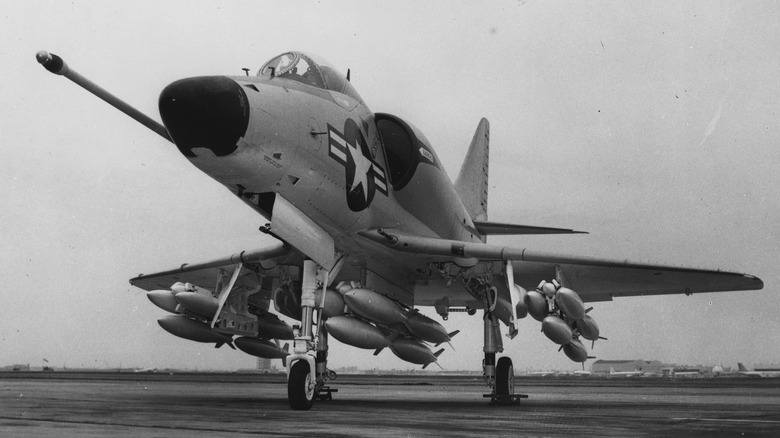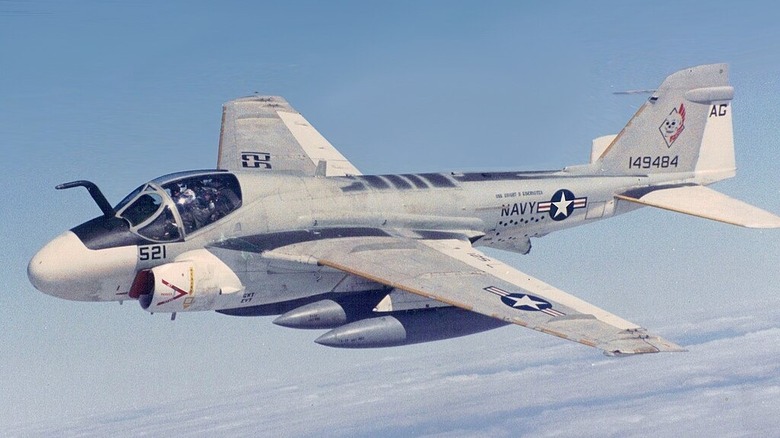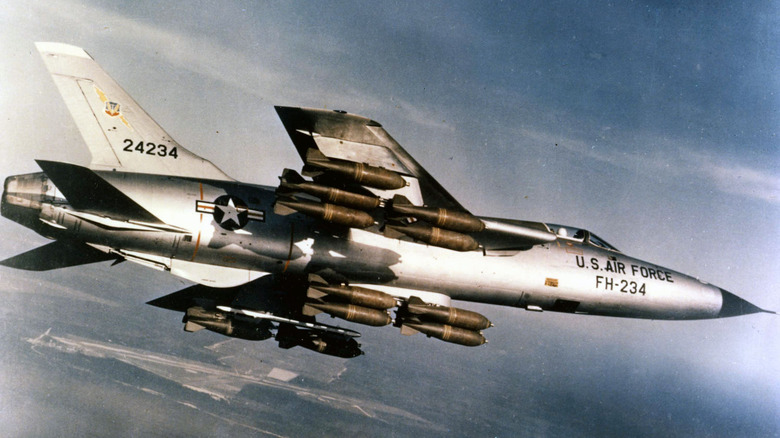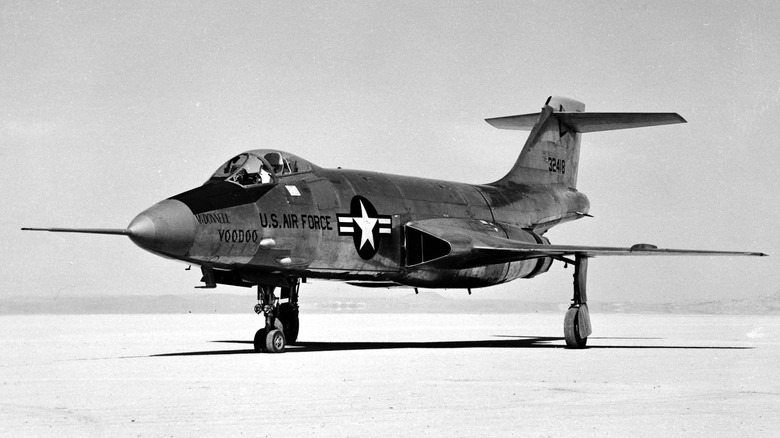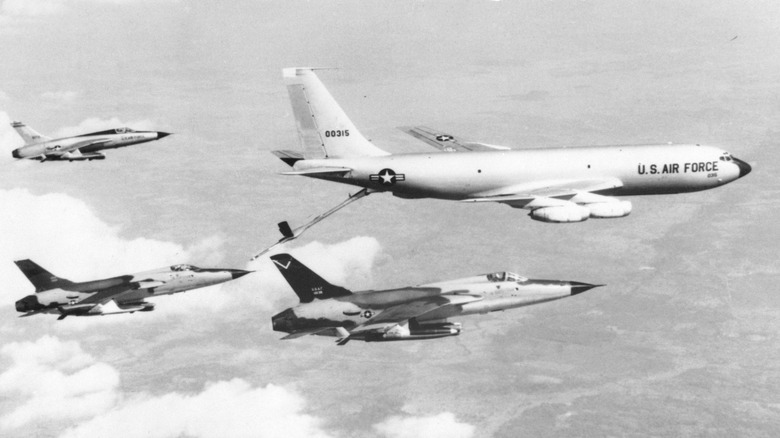American Jets That Made A Difference During The Vietnam War
Saigon fell to North Vietnamese forces on April 30, 1975. After a 21-year struggle, Vietnam was united under the communist banner, disproving General George Patton's claim on June 5, 1944, that the American people would never lose a war, owing to their winner-loving mentality. However, had Patton lived to see the ignominious spectacle of hasty evacuations and overboard helicopters, he would have no doubt lambasted the North Vietnamese victory as a strictly political one — and Old Blood and Guts would have been right.
North Vietnam never won a military victory against the United States, not even during the 1968 Tet Offensive, which was a tactical American victory despite the negative effect it had at home. U.S. forces won the Tet onslaught with formidable ground troops and a dynamic air force that provided transportation, air support, reconnaissance, bombing raids, and numerous other offensive and defensive functions.
Throughout the conflict, the United States Air Force innovated wholesale advancements in aerial strategy and technology, from aerial refueling and "Wild Weasel" bombing raids to night vision, AN/TPS-25 radar, and precision-guided munitions. The chopping rotary blades of the Bell UH-1 Iroquois "Huey" may be one of the most iconic images of the era, but the advanced jets of the Vietnam War are what truly bolstered American air power — here are the ones that made a difference.
North American F-100 Super Sabre
The North American F-100 Super Sabre was the United States' first supersonic jet fighter. The F-100D variant entered Vietnam in February 1965 and maintained consistent service throughout the war. The Super Sabre was capable of both offensive and defensive missions, from reconnaissance and air patrol to flak suppression, ground attack, and bombing.
Development began in 1951 when North American Aviation approached the United States Air Force with the "Sabre 45," a proposed successor to the F-86 Sabre. After numerous modifications, the USAF ordered two prototypes on January 3, 1952. The F-100A variant entered service on September 17, 1954.
Despite the cutting-edge technology, the F-100A had numerous stability problems that caused six accidents in the first two months of operation, including one that resulted in the death of test pilot George Welsh on October 12, 1954. North American managed these issues with the F-100C and F-100D variants, the latter of which became the dominant F-100 series aircraft in the conflict.
The F-100D had a 16,950 pound-thrust Pratt & Whitney turbojet that achieved a cruising speed of 565 mph and a max speed of 824 mph. The 7,500-pound loadbay could carry nuclear warheads and mounted on the fuselage were four M-39 20mm cannon. The F-100's adaptable, well-rounded power saw it fly more sorties than any other American aircraft during the war. It was especially effective during the Tet Offensive in 1968. According to Smithsonian historian Larry Burke, F-100Ds were used "constantly" during the campaign, hammering the enemy with powerful ground attacks.
Lockheed C-141 Starlifter
Combat jets with fierce offensive and defensive capabilities may capture the popular imagination of what a military aircraft is, but the United States Air Force could not have functioned during the Vietnam War without the logistical power of aircraft such as the Lockheed C-141 Starlifter.
A 145-foot cargo plane with a maximum load of 316,600 pounds, the Starlifter carried masses of men and materiel throughout the conflict. An early test came in December 1965 during Operation Blue Light, in which 12 Starlifters and four Douglas C-133 Cargomasters transported the 3rd Brigade, 25th Infantry Division to Pleiku, South Vietnam. By early 1966, the Starlifters had shifted the majority of 3,000 men and up to 4,000 tons of equipment.
The Starlifter impressed not just with its size but also its speed: The aircraft cut a roundtrip between California and Saigon from 95 hours to just 34 hours — a decrease of over 64%. The Starlifter's haste and stability were ideal for transporting fragile blood donations, which peaked at 37,000 pints in March 1969. The Starlifter's most famous humanitarian efforts came during the American exodus in 1973, when the aircraft repatriated almost 600 American prisoners of war, earning the moniker "Hanoi Taxi." The Starlifter reprised this role during the Fall of Saigon in 1975, rescuing scores of Vietnamese refugees and American personnel.
Douglas A-4 Skyhawk
The Douglas A-4 Skyhawk was the U.S. Navy's most prolific attack aircraft of the Vietnam War. It entered the conflict in August 1964, during the notorious Gulf of Tonkin Incident, which drastically escalated the United States' military commitment in Southeast Asia.
The Skyhawk was designed to replace the A-1 Skyraider and, barring some early issues with the instrument panel, cruise power, and the thrust-to-weight ratio, the project was a success. By the mid-1960s, the A-4's many variants — C, D, E, F, M, TA-4F — presented the U.S. military with a fleet of powerful aircraft with light frames, sizeable bomb loads, sophisticated radar systems, 20mm guns, and engine thrusts of between 7,700 pounds and 11,200 pounds.
The Skyhawk excelled in many engagements. During Operation Starlite in August 1965, Skyhawks neutralized North Vietnamese attacks on troops, vehicles, and materiel at Chu Lai, near Da Nang. Ground attacks such as these caused Skyhawks to be popular with Cessna reconnaissance pilots, who valued the Skyhawk's speed in responding to their intelligence and hitting the targets. Further notable service occurred during the Tet Offensive, which Skyhawks helped break with explosives, napalm, and 20mm cannon fire. The strikes were in vain, however, because the army failed to exploit the break and subsequently withdrew units from the area.
384 Skyhawks were lost during the war, including an A-4E flown by future Senator John McCain, who was shot down over Hanoi by a surface-to-air missile on October 26, 1967.
McDonnell Douglas F-4 Phantom II
A supersonic fighter-bomber of the United States Navy, the McDonnell Douglas F-4 Phantom II soared above Southeast Asia with formidable weaponry and a pair of General Electric J79 turbojets that thrust the aircraft to a max speed of 1,500mph. Historian Bill Gunston wrote that the F-4 Phantom II did more than any other weapon to hold the Vietcong at bay.
The F-4 had superior performance in dog fighting, reconnaissance, and forward air control. It also had a substantial, 16,000-pound ordnance delivery. The F-4 was the United States' most successful aircraft against North Vietnam's MiG aircraft. On January 2, 1967, F-4s based in Ubon, Thailand, shot down seven MiG-21s during Operation Bolo over the Red River Valley in North Vietnam. In total, F-4s destroyed 107 of the Soviet-made jet fighters with 20mm guns, maneuvering tactics, and especially its arsenal of rockets, which included the AIM-7 Sparrow, AIM-4 Falcon, and AIM-9 Sidewinder.
Sophisticated radar technology buttressed the F-4's offensive capabilities, allowing its two-pilot crew to engage enemy aircraft beyond visual range, although this function was unreliable in some models. Furthermore, Secretary of Defense Robert McNamara undermined the aircraft's radar with the order that MiGs had to be clearly identified and understood to be displaying hostile intent before any action could be taken.
While the F-4 was not a perfect aircraft, pilots and crews generally considered it to be a capable, all-round workhorse, and many consider it one of the most iconic fighter jets ever built.
Grumman A-6 Intruder
The pioneering Grumman A-6 Intruder was the U.S. Navy's first plane to advance deep into North Vietnam, owing to its Digital Integrated Attack and Navigation Equipment (DIANE), which had terrain-following radar that allowed the A-6 to operate in dark, monsoon conditions. The Intruder's command of the environment helped it drop over half the war's ordnance despite serving in only 20% of all bombing missions. It also caused the plane to become a flying point man, relaying DIANE information to nearby A-7 Corsairs and F-4 Phantoms, who dropped their ordnance accordingly.
Twin Pratt & Whitney J52 turbojet engines propelled the Intruder to a maximum speed of 684 mph or 546 mph with a full bomb load. These were modest speeds compared to North Vietnam's MiG fleet, but the Intruder's main concern wasn't fighter planes but anti-aircraft fire and especially surface-to-air missiles (SAM), which claimed 10 Intruders during the war.
Fortunately, Intruder crews were adept at identifying and evading these missiles. "You could outfly the SAMs with the A-6," said Rear Admiral Rupe Owens in an interview with the Smithsonian. "What you did was make hard turns. At their intercept speed of about Mach 3, the SAMs couldn't turn with the A-6, especially at low level."
Perhaps the A-6's most important variant was the EA-6 Prowler. The so-called "Chariot of Electronic Armageddon" used a suite of technology to jam enemy communications and wielded AGM-88 HARM anti-radiation missiles to take the fight to the enemy.
[ Featured Image by U.S. Navy via Wikimedia Commons | Cropped and scaled | CC BY-SA 4.0 ]
Republic F-105 Thunderchief
The F-105 Thunderchief was an icon of the skies, and the backbone of the U.S. Air Force's offensive capacity during the Vietnam War, flying more sorties in North Vietnamese territory than any other aircraft in the American fleet. The fighter-bomber was armed with an M61 Vulcan 20mm gun loaded with up to 1029 rounds. A typical bombload included six general-purpose bombs, weighing either 750 or 1000 pounds each, and two 3000-pound M118s. For air-to-air defense, the F-105 had AIM-9 Sidewinder missiles.
The F-105D variant was introduced during Operation Rolling Thunder — the massive U.S. air power campaign against North Vietnamese military infrastructure from March 1965 to October 1968. With new avionic systems ALQ-105 jamming pods, the F-105D became the spearhead of the Wild Weasel project, which targeted surface-to-air missile (SAM) stations throughout enemy territory.
The Wild Weasel raids were among the most dangerous missions of the Vietnam War. For instance, during Operation Spring High in July 1965, F-105s skimmed through a valley at below 50 feet, which was so low that North Vietnamese anti-aircraft guns couldn't aim low enough to hit them. Five U.S. airmen died in the mission, destroying two SAM sites that turned out to be decoy bamboo constructions. However, the knowledge gained from the strike proved invaluable; over the next two years, U.S. strikes increased the average number of SAMs it took to destroy a single U.S. aircraft from 17 to 32.
[ Featured Image by USAF via Wikimedia Commons | Cropped and scaled | CC BY-SA 4.0 ]
McDonnell F-101 Voodoo
A tactical aircraft with nuclear capabilities, the McDonnell F-101 Voodoo was among the most powerful American jets of the Vietnam War. It was big, too. In fact, at over 67 feet long and 48,000 pounds with a full load, the F-101A variant was the largest single-seat ever built at that time. Despite this heft, the Voodoo's combination of speed, range, and APS-54 search radar caused the plane to be the only U.S. aircraft that could make regular daytime raids into the deepest parts of North Vietnam's interior.
Consequently, F-101s served as the world's first supersonic photo reconnaissance aircraft, capturing broad and detailed imagery of enemy infrastructure. Numerous divisions of the Reconnaissance Squadron used the Voodoo, especially the 45th unit, which flew the plane over enemy territory constantly for 8 years.
Despite its extensive reconnaissance use, the Voodoo did not want for weaponry; it boasted four 20mm cannons, three Hughes GAR-1 Falcon radar-homing missiles, and as many as 12 unguided rockets. Still, the plane's properties were considered best applied in a pathfinding capacity, such as on February 8, 1965, when a formation of Voodoos directed a group of F-100 Super Sabre in the first North Vietnamese strike of the war.
[ Featured Image by USAF via Wikimedia Commons | Cropped and scaled | CC BY-SA 4.0 ]
Boeing KC-135A Stratotanker
Aerial refueling was a vital procedure during the Vietnam War. Over 1.6 billion gallons of jet fuel were delivered this way to bombers, fighters, and other aircraft, and the KC-135A Stratotankers shouldered the majority of this heavy burden. Powered by four Pratt and Whitney J-57-P-59W engines, the behemoth could carry 31,250 gallons of fuel, which was enough for eight F-100s or 10 F-4s. Without them, fighter-bomber missions would have lost hundreds and thousands of miles, severely blunting the air force's power.
A veritable workhorse, the USAF's 100-strong Stratotanker force flew 94,687 sorties over the war and conducted 813,878 refuelings. The plane was capable in an emergency, too, such as when a damaged F-4D Phantom issued a "mayday" call in August 1972. A Stratotanker found the aircraft, took control, and refreshed the Phantom's leaking tank until it could land safely.
The KC-135A Stratotanker is one of just a few U.S. aircraft that saw service into the 21st century, owing to a raft of successful upgrades to its electronics, communications, and engines. In 2019, the Boeing KC-46 Pegasus Tanker entered service as an ostensible replacement for the Stratotanker, but it is unclear when that will be realized.
B-52 Stratofortress
The United States dropped 6.166 million tons of bombs on Southeast Asia during the Vietnam War, which is almost three times more than the combined 2.150 million tons American forces dropped in the Pacific and European theaters of World War II. It is estimated that the B-52 Stratofortress heavy bomber dropped about a third of this terrible payload, which means the aircraft dropped roughly the same amount of ordnance as the entire U.S. Air Force during the war against Hitler and Hirohito. These sobering statistics explain why the B-52 was among the most feared weapons of the Vietnam War, and why variants of the bomber remain in service to this day.
Despite an individual B-52D carrying a bomb load of up to 60,000 pounds, the aircraft rarely struck their targets alone. Instead, B-52s typically flew in groups of six, ravaging an area one mile long and one half mile wide with around 80 tons of explosives.
The aircraft were effective in numerous operations. In 1968, B-52s out of Guam helped break the siege of Khe Sanh, reducing enemy positions into "stubble fields." Years later, in December 1972, President Nixon launched Operation Linebacker II, in which formations of B-52s dropped some 15,000 tons of explosives on targets across the Hanoi/Haiphong port area. Some argued that this intense operation was instrumental in securing the Paris Peace Accords, which ended American military engagement on January 27, 1973.
